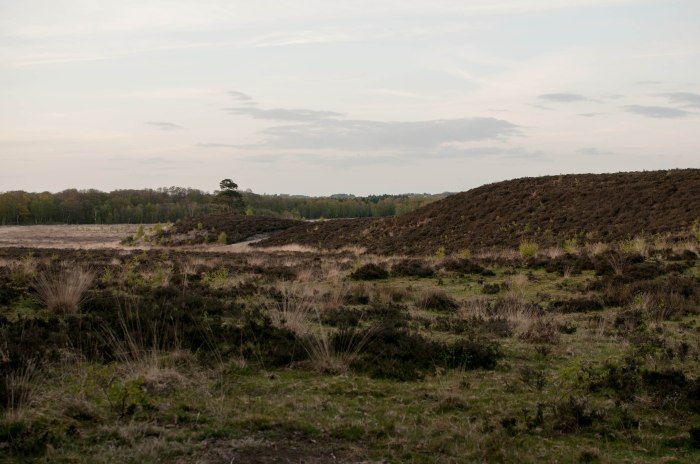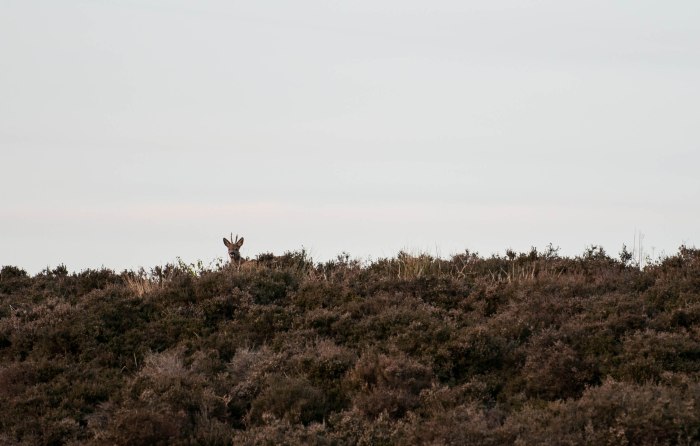‘Distilled by the sun, kneaded by the moon, it is renewed in a year, in a day, or in an hour. The sea changed, the fields changed, the rivers, the villages, and the people changed, yet Egdon remained.’ – The Return of the Native by Thomas Hardy.
The approach to Dersingham Bog is down the steep bank of an escarpment, and onto a valley floor the depth of which is exaggerated by the soaring pines on its sides. The worn earth of the path along the valley bottom leads over the heaved undulations of tree roots. Since I was last here a massive Scots pine has been felled, its limbless trunk is stretched quietly next to the dark heart of the corrupted stump. After fifty yards or so, the pines give way to newly-greened silver birch; the slender frames of young trees gathered together like a group of nervous fawns shivering in the fading breeze. The valley is formed by two outstretched arms of the escarpment reaching towards the Wash which lies out of view, beyond more pine plantations of the Sandringham Estate, and a mile of glacier-skimmed farmland.

After another couple of hundred yards the valley opens. The spur to my right is cut in two by a deep path that follows the foot of the escarpment where once the sea reached; now it is waves of ling heather that break upon the hills. This is a heavily managed environment, the irony of which lies awkwardly across the darkening landscape. This is one of the few remaining ‘wild’ places left amongst the farmland of Norfolk; much has been surrendered to the ingress of intensive agriculture and its anachronistic partner game-shooting in sorry capitulation. I have nothing in principal against game shooting, I enjoy eating it in season, and it is something that I have often considered trying, but I don’t buy the idea that we should somehow be thankful for the way our landscape looks today because of it. That suggests if landowners didn’t have an interest, either recreational or financial, in providing suitable habitat for game birds, then we would have witnessed an even more drastic reduction of hedgerows and other habitats than has otherwise taken place. Surely nature for nature’s sake should be enough, not nature as by-product of financial dogma? What’s more I find it impossible to reconcile the fact that indigenous species labelled as ‘vermin,’ are exterminated in their thousands to protect the thirty million or so non-indigenous pheasants released every year with the sole purpose of being shot. Is it me or does the absurdity of that situation seem impossible to fathom? Again, I am not against certain species being culled as and when necessary to protect vulnerable or endangered species, but it is the indiscriminateness of game-keeping, mired as it is in Victorian attitudes, that must change. But I digress. It is Natural England who attempt to keep the three key habitats of mire, heath and woodland here intact. Lowland heath such as this was formed by the clearing of woodland for fuel and grazing during the agricultural revolution when we moved from hunter-gathering to farming. According to the Wildlife Trusts there are now only 58000 hectares of this habitat left in England – a sixth of what was present at the beginning of the nineteenth century – and it continues to disappear at approximately fifteen per cent every decade. To add insult to this injury seventy-five per cent of what remains is rated as in poor condition. But still these petri dishes of heathland, bombarded by the antibiotics of intensively farmed agriculture, are refuges where many species bloom. Reptiles such as adders thrive here, but population isolation and the subsequent reduction in genetic diversity puts their long-term survival in an uncertain position. Five thousand species of invertebrate inhabit heathland, and some very specialist birds, including the Dartford warbler, though they are currently restricted to further South, and East.
Maybe one of our most famous areas of heathland is actually fictitious, or semi-fictitious anyway. The Egdon Heath of Hardy’s Wessex landscape is said to be made up of the many areas of heathland that existed at the time he was writing. That more irony seeps across this landscape is apparent in Hardy’s words above, for in fact if Egdon had existed in reality, it would now be as endangered as the genuine article.

The escarpment is behind me now, and I am amidst the open heather. Below, the bog that gives this reserve its name stretches to a small, still lake, beyond which more pines hem the reserve in along the line of the coast road. The light and breeze of day are gradually failing, though it wants half an hour at least before true twilight. Some of the creatures of the day are still active, although behind me I can see a roe deer buck silhouetted on the curving spur of the valley. He stares back at me before slipping away. Pheasants give their familiar rasping calls: ‘Chooor-chuk!’ The abrupt, upturned ‘chuk,’ is followed immediately by a drumming of wings: ‘Chooor-chuk! Brrrrrr.’ A cuckoo calls from an isolated pine that stands amidst the heather.

Scrolling curlicues of cirrus are beginning to pink as the sun sets, and there is a brief moment of handover from the day shift to the night shift. There is a bit of overlap – the occasional ‘Choor-chuk!’ – but as the light really begins to fade, the night shift takes over. It may be rather clichéd but there really is the wavering hoot of tawny owls, and the sharp, acid bark of a fox. There is also something else, though still not what I am actually here for. ‘Groak-groak-gr-gr-groak. Tsew! Groak-groak-gr-gr-groak-groak.’ The portly bird with the strange, croaking call passing overhead is a woodcock. He continues his night-time foray with a steady, straight flight to the far side of the reserve. Staying just above tree-top height he swings round along the line of the pines and then over again all the while continuing his weird, throaty groaking, and single, high pitched ‘tsew!’ This tree-top flight is a courtship display named ‘roding.’ The woodcock is a quarry species, meaning they can be shot in season, though they are apparently notoriously difficult to hit because of their small size, and jinking flight. Preparing it for the table is relatively easy. Once plucked and roasted, the guts are removed, and spread on toast. The bird itself is then served on top of the toast upon which its guts are spread. You may also, if so inclined, suck the brains from the skull; they are supposedly particularly good, though I prefer my woodcock groaking overhead on an evening such as this.

Weird and lovely as the sound of the Woodcock is, it is not what I am here for. In Spring nature’s afferent unpredictability is at its best, bubbling up through Winter’s mantle, and dependant on the whim of the wind and weather not just here, but thousands of miles away. But it so happens that tonight Spring has flowed into this little corner of Norfolk, and somewhere out amongst the heather, the nightjars are waking from a day of hidden slumber. The churring of the nightjar is a difficult sound to describe. It’s a throaty, rolling churr that swells and then surges as more birds join in, then fades and falls, before rising again. Once the birds leave the cover of the heather to feed on the moths, and other insects which they catch on the wing, they are visible through the gloaming. Their wings come together in an occasional loud clap, and the daubed whitewash on each wing, and opposite corners of the ends of their tails, flash like semaphore lamps through the gloom. In flight they utter a single ‘Koo-wick,’ call, while clap-clap-gliding with wings in a v, and broad tails fanned. The nightjar was once known as the goatsucker because of the belief that it stole milk from the udders of goats. Creatures of the night were commonly associated with superstitions such as these. It has been a shorter display this year than some I have seen, only one individual coming close enough for me to see.

I don’t feel scared at night in the countryside; today there is more to be feared walking through the local town centre at this time. There is though, the natural apprehension of the dark as I approach the narrow reach of the valley on the way back to the car, where the pines are looming totems; heads somewhere high in the shadows. There are cracks and rustles in the bracken and heather. Two fallow deer start near the birches. I watch their pale bellies as they go up the hillside in impossibly long bounds, and stop at the top to stare down at me like the roe deer earlier. The anxiety induced by modern society dissipates out here, alone in the dark, with the calls and sounds of the wild.